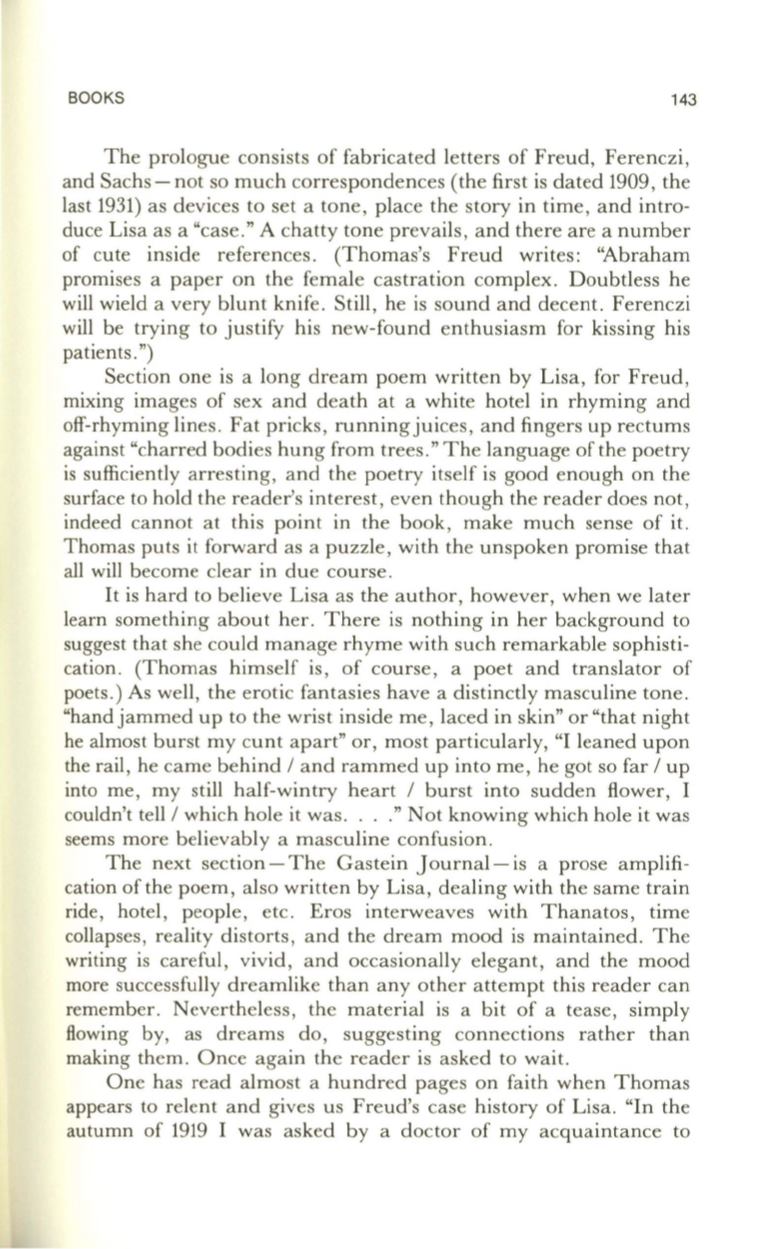
BOOKS
143
The prologue consists of fabricated letters of Freud, Ferenczi ,
and Sachs- not so much correspondences (the first is dated 1909, the
last 1931) as devices to set a tone, place the story in time, and intro–
duce Lisa as a "case." A chatty tone prevails, and there are a number
of cute inside references. (Thomas's Freud writes: ''Abraham
promises a paper on the female castration complex. Doubtless he
will wield a very blunt knife. Still, he is sound and decent. Ferenczi
will be trying to justify his new-found enthusiasm for kissing his
patients. ")
Section one is a long dream poem written by Lisa, for Freud,
mixing images of sex and death at a white hotel in rhyming and
off-rhyming lines. Fat pricks, running juices, and fingers up rectums
against "charred bodies hung from trees. " The language of the poetry
is sufficiently arresting, and the poetry itself is good enough on the
surface to hold the reader's interest , even though the reader does not,
indeed cannot at this point in the book, make much sense of it.
Thomas puts it forward as a puzzle, with the unspoken promise that
all will become clear in due course.
It
is hard to believe Lisa as the author, however, when we later
learn something about her. There is nothing in her background to
suggest that she could manage rhyme with such remarkable sophisti–
cation . (Thomas himself is, of course, a poet and translator of
poets.) As well, the erotic fantasies have a distinctly masculine tone.
"hand jammed up to the wrist inside me, laced in skin" or "that night
he almost burst my cunt apart" or, most particularly, "I leaned upon
the rail, he came behind / and rammed up into me, he got so far / up
into me, my still half-wintry heart / burst into sudden flower , I
couldn't tell / which hole it was ...." Not knowing which hole it was
seems more believably a masculine confusion.
The next section - The Gastein
J
ournal- is a prose amplifi–
cation of the poem, also written by Lisa, dealing with the same train
ride, hotel, people, etc . Eros interweaves with Thanatos, time
collapses , reality distorts, and the dream mood is maintained. The
writing is careful, vivid, and occasionally elegant , and the mood
more successfully dreamlike than any other attempt this reader can
remember. Nevertheless , the material is a bit of a tease, simply
flowing by, as dreams do, suggesting connections rather than
making them. Once again the reader is asked to wait.
One has read almost a hundred pages on faith when Thomas
appears to relent and gives us Freud's case history of Lisa. "In the
autumn of 1919 I was asked by a doctor of my acquaintance to


